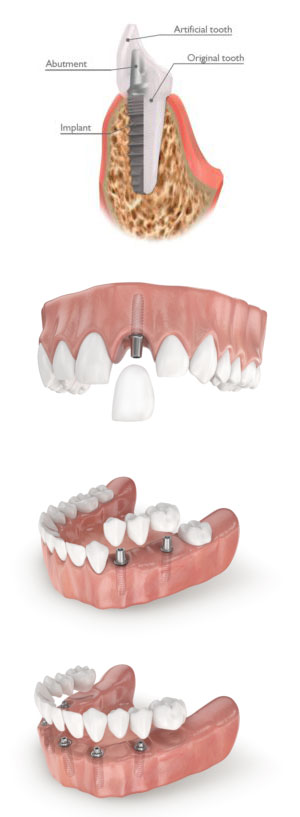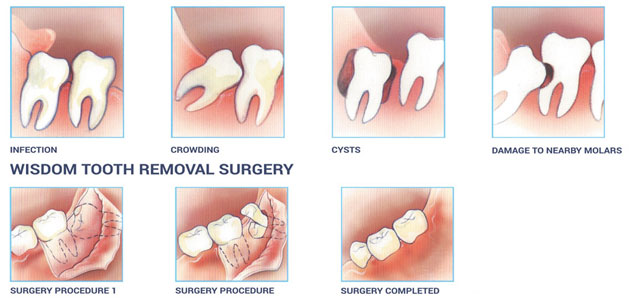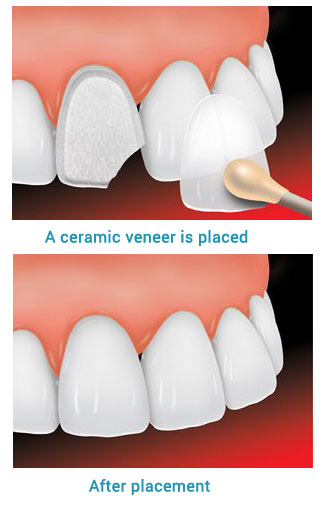Cosmetic Dentistry :
 Tooth whitening can be a very effective way of lightening the natural color of your teeth without removing any of the tooth surfaces. It cannot make a complete color change, but it may lighten the existing shade.
Tooth whitening can be a very effective way of lightening the natural color of your teeth without removing any of the tooth surfaces. It cannot make a complete color change, but it may lighten the existing shade.
There are a number of reasons why you might get your teeth whitened. Everyone is different; and just as our hair and skin color vary, so do our teeth. Very few people have brilliant-white teeth, and our teeth can also become more discolored as we get older.
Your teeth can also be stained on the surface by food and drinks such as tea, coffee etc. Smoking can also stain teeth.
‘Calculus’ or tartar can also affect the color of your teeth. Some people may have staining under the surface, which can be caused by certain antibiotics or by tiny cracks in the teeth which take up stains.
Types of Bleaching:
Professional Bleaching: also called as In-Office Bleaching or Chair side bleaching and usually requires only one visit. The Dentist will apply a protective gel to the gums and then bleaching agent on the teeth. Whitening products contain tooth bleaching agents (hydrogen peroxide or carbamide peroxide). These bleaches break stains into smaller pieces, which make the color less concentrated and your teeth brighter.
At Home Bleach: For this type of bleach a custom-made tray is provided by the dentist. In this case, the dentist will give you instructions on how to place the bleaching solution in the tray and for what length of time. This may be a preferred option if you feel more comfortable whitening in your own home.
Tooth replacement :
 The most common methods of treating lost teeth are dental bridges and dentures, Over time, a denture will fit less and less well. In some patients, the reason for this is the progressive loss of the jawbone tissue under the denture, while others may experience hypertrophy of the oral mucosa under the denture.
The most common methods of treating lost teeth are dental bridges and dentures, Over time, a denture will fit less and less well. In some patients, the reason for this is the progressive loss of the jawbone tissue under the denture, while others may experience hypertrophy of the oral mucosa under the denture.
The wearer of a loose denture is unable to chew food properly, which can subsequently cause severe disorders of the digestive tract. In addition, the denture may also inhibit the patient from enjoying a full social life.
How do implants work?
An implant is an artificial replacement of the tooth root, inserted in the jawbone, to replace the missing root of the original tooth. Together with the abutment, it creates a base for attaching the crown. The implant is made of titanium, which is not rejected by bone tissue. On the contrary, it creates a direct and tight bond with it.
Single tooth restoration
The implant has the full functionality of the original tooth and no one can see the difference.
Multiple tooth restoration
One option is an implant-supported bridge. It is not necessary to prepare the healthy neighboring teeth and the implants also prevent bone loss and deformation of the face.
Full-arch restoration
Implants can also be used as a solution for the loss of all teeth. Thanks to the perfect healing of the implants into the jawbone, there is no need to worry about the teeth staying in place.
What is the treatment process like?
First, the implant, in the shape of a small screw, is inserted into the jaw in place of the removed tooth. As soon as the implant has healed over the following weeks, the abutment is fixed onto the implant. An artificial ceramic tooth, indistinguishable from the original one and with a strong bite, is then fixed onto the abutment.
 A crown is a cover or “cap” your dentist can put over a tooth. The crown restores the tooth to its normal shape, size, and function. A crown can make the tooth stronger or improve the way it looks.
A crown is a cover or “cap” your dentist can put over a tooth. The crown restores the tooth to its normal shape, size, and function. A crown can make the tooth stronger or improve the way it looks.
When your tooth is damaged but not lost, a dental crown is the best alternative to restore its structure and function.
Crown often called as “Cap” is an artificial tooth that covers the damaged tooth. It encicrcles the prepared natural tooth, thus giving it back the natural appearance and desired strength.
Reasons you may need a crown :
1. You have a cavity that is too large for a filling
2. You have a tooth that is cracked, worn down, or otherwise weakened.
3. You have had root canal treatment — the crown will protect the restored tooth.
4. You want to cover a discolored or badly shaped tooth and improve your smile.
Steps of placing a crown :
It usually takes 2 dental visits to complete the treatment. When a crown is placed over a natural tooth, several steps are involved:
Your dentist prepares the tooth by removing its outer portion so the crown will fit. Any decay is also removed. If additional tooth structure is needed to support the crown, your dentist may build up the core of the tooth.
An impression is made to provide an exact model for the crown. The impression can be made from a mold or by digitally scanning the tooth.
You may get a temporary crown while you wait for the permanent crown to be ready. This usually takes less than 2 weeks. While you have a temporary crown, the tooth may be sensitive to hot and cold. Avoid chewing gum and eating sticky foods during this time. If your dentist has special equipment, then you may be able to get your new crown on the same day.
When the new crown is ready, your dentist places it in your mouth and makes the necessary adjustments. When you and your dentist are happy with how it looks and feels, the crown is cemented into place.
 Wisdom teeth usually cause no problems, but if there isn't enough space for them to grow they can cause pain, swelling, infection or damage to other teeth. Surgical removal (extraction) of one or more wisdom teeth can help to resolve these problems.
Wisdom teeth usually cause no problems, but if there isn't enough space for them to grow they can cause pain, swelling, infection or damage to other teeth. Surgical removal (extraction) of one or more wisdom teeth can help to resolve these problems.
Problems associated with Wisdom Teeth:
Wisdom teeth that are healthy and in the right position usually don’t cause problems. You may have a problem if any of the following occur:
1. Your wisdom teeth break through your gums only partway because of a lack of space. This can cause a flap of gum tissue to grow over them. The flap can trap food and lead to a gum infection.
2. They come in crooked or facing in the wrong direction causing cheek bite and ulcers at times.
Do I need Removal of Wisdom Teeth?
1. Pain or jaw stiffness near an impacted tooth.
2. Pain or irritation from a tooth coming in at an awkward angle and rubbing against your cheek, tongue, or top or bottom of your mouth.
3. An infected swelling in the flap of gum tissue that has formed on top of an impacted tooth that has broken partway through the gum.
4. Crowding of other teeth.
After Surgery
Dos:
- Use an ice pack on your face to curb swelling or skin color changes.
- Gently open and close your mouth to exercise your jaw.
- Eat soft foods
- Drink plenty of fluids.
- Brush your teeth starting the second day. Don’t brush against any blood clots.
- Take the drugs your doctor prescribes to ease pain or swelling.
Don’ts:
- Don’t drink through a straw. Sucking may loosen blood clots that help your mouth heal.
- Don’t rinse your mouth too harshly. Your doctor may suggest rinsing gently with saltwater.
- Don’t eat hard, crunchy, or sticky foods that may scratch your wounds.
- Don’t smoke. Smoking can slow your healing.
What is a veneer?
 A veneer is a thin layer of porcelain made to fit over the front surface of a tooth, like a false fingernail fits over a nail. Sometimes a natural-colour ‘composite' material is used instead of porcelain.
A veneer is a thin layer of porcelain made to fit over the front surface of a tooth, like a false fingernail fits over a nail. Sometimes a natural-colour ‘composite' material is used instead of porcelain.
Dental veneers are a possible solution to help you achieve the look you desire. They are a popular choice for those with chipped teeth, a gap between teeth, or misshaped teeth.
1. teeth that are stained and can’t be whitened by bleaching
2. chipped or worn teeth
3. crooked or misshapen teeth
4. uneven spaces or a large gap between the upper front teeth
Porcelain Veneers :
A porcelain veneer is a thin shell that is custom-made to fit on the tooth.
Benefits of porcelain veneers:
![]() they are strong and long-lasting
they are strong and long-lasting
![]() they have a natural-looking surface
they have a natural-looking surface
![]() less tooth enamel needs to be removed than with a crown or cap
less tooth enamel needs to be removed than with a crown or cap
![]() they don’t stain easily
they don’t stain easily
Composite resin veneers :
A composite resin veneer is made from a tooth-colored filling material bonded to the tooth.
Benefits of composite resin veneers:
![]() usually less tooth enamel needs to be removed than for crowns or porcelain veneers
usually less tooth enamel needs to be removed than for crowns or porcelain veneers
![]() may mean fewer visits to the dentist—sometimes these veneers take just one visit
may mean fewer visits to the dentist—sometimes these veneers take just one visit
![]() cost less than porcelain veneers
cost less than porcelain veneers
![]() are easy to fix if they get damaged; although composite veneers are generally not as strong or wear-resistant as porcelain veneers, composite veneers can be repaired easily and quickly
are easy to fix if they get damaged; although composite veneers are generally not as strong or wear-resistant as porcelain veneers, composite veneers can be repaired easily and quickly
